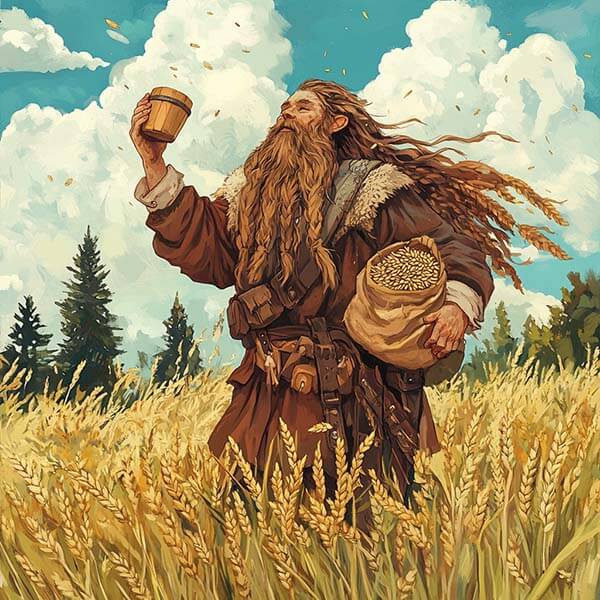
Pekko
God of Crops and Brewing
Karelian / Finnish Mythology
The first reference to Pekko is during the wedding of Ilmarinen and the Maiden of Pojhola. In this part of The Kalevala, Osmotar, the creator of beer, must create a sacred drink to bless the wedding. While Osmotar discovers the secret of fermenting, Pekko provides her barley crops to brew the sacred beer.
Barley is one of the most significant crops in the Kalevala. In the creation story of The Kalevala, the world is not complete until the creation of barley.
Brewing beer is integral to the Finnish identity and is referenced several times throughout the Kalevala. It brings communities together and symbolizes abundance. Similar to Akka, he is critical for crops. However, the crops in his domain are primarily for agriculture.
Pekko originates from the Karelian region. However, he has counterparts in Estonia (Pikne), the Baltics (Perkūnas), and sometimes with Christianity in the form of Saint Peter.
Agriculture, fertility, and brewing are key aspects of the Kalevala. While Pekko is little mentioned in the poems and songs, his symbolism is inherent.
- Domain: Agriculture, barley, brewing
- Realm: The Earth
- Symbol: Barley
- Weapon/Relic: None
- Spouse: None
- Worship: Brewing ceremonies and agricultural rituals
- Offerings: Barley, Sahti, beer, harvest, bread
- Holidays: Kekri, Juhannus, Spring planting
Creation of Sahti
Sahti is one of the oldest brewing styles that is still used today. Its creation comes from farmhouse brewing and may have been inspired by Pekko. Sahti’s traditional brewing uses barley, rye, or oats.
Some evidence suggests that sahti has been around since the 9th century. The discovery of casks on sunken Viking ships led historians to believe the brewing practice existed in that period. In 1366, the first written evidence of sahti emerged in texts of a bishop’s burial, describing the amount of beer he drank.
Celebrating Pekko
Pekko’s celebrations continued after the adoption of Christianity. Before Pentecost, during Candlemas and Midsummer, Finns paid tribute to him. Lighting black candles and placing wooden effigies of Pekko near grain stocks celebrated the harvest Pekko provided.
Kekri (The Harvest Festival)
Finns pay tribute to Pekko during the sowing and harvest seasons. Most notably, during Kekri, or the harvest festival, Finns worship Pekko to gain a bountiful harvest. Wooden effigies with holes for candles in the head were left near granaries to honor Pekko.
Marking the end of the harvest season, Finns partake in feasts, libations, and saunas. The Kekri Festival originally fell on September 29th, but it was later changed to correspond with All Saints Day on November 1st. With this change, the Finns began honoring the spirits of ancestors in conjunction with the other revelries.
Spring Planting Festival
Farmers often scatter barley seeds to honor Pekko during the spring planting season. Beer from last year’s harvest and the first sowing are usually gifts provided as tribute. Today, the Spring Planting Festival isn’t celebrated as widely as it used to. However, a modern convention, Spring Garden (Kevätmessut), takes place in Helsinki and serves as a horticultural trade fair.
Juhannus
Juhannus is an integral holiday in Finland and other Nordic countries. This festival corresponds with the summer soltices and is often referred to as Midsummer Festival. Weddings are often organized around Juhannus as it symbolizes fertility, renewal, joy, and community.
Beer and sahti are integral parts of the Juhannus festival. While many do not specifically honor him, beer brewing holds strong symbolism in the Midsummer Festival. The Nordic countries revel during the Midsummer Festival, partaking in libations as they enjoy endless daylight.
